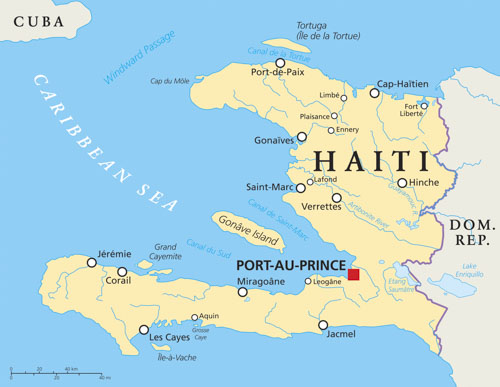Coastline in Ouest, Haiti. Ouest is one of the ten departments of Haiti and home to the country’s capital, Port-au-Prince.
Written by Lauren-Rose Stunell
Shaped by History
Haitian Creole, also known as Kreyòl or just Creole, is one of Haiti’s official languages, alongside French. This language is a unique blend of French as the root with influences from Portuguese, Aramaic, Spanish, Taìno, and West African languages. If you and your students enjoyed discovering the Michif language and its Cree and French roots, keep reading to discover Haitian Creole as another unique French-based language!
Haiti, a country on the island of Hispaniola in the Caribbean, gained independence in 1804 following a slave revolt. The origins and development of Haitian Creole are also tied to the colonization of the Caribbean and the history of slavery in Haiti. In what is now Haiti, the Creole language developed through interactions between French colonists and African slaves in the 17th and 18th centuries. This contact language was “a form of African resistance against slavery.” The French colonial authorities recognized the importance of the language and even translated public legal declarations into Haitian Creole.

Following the slave revolt of 1804, Haiti was the first nation in Latin America and the Caribbean to gain independence and the first in the Americas to eliminate slavery. It was also the first independent nation led by Black citizens in the entire world. What an honour to bring light to the resilient history of this nation and language during Black History Month! Each part of Haiti’s history leading up to its independence has left a mark on Haitian Creole, which is now spoken by between 10 to 12 million people worldwide.
A Personal Story from a Special Student
I was very excited to research and discover this language because one of my Grade Six students and her father are immigrants from Haiti and shared with me their thoughts about their maternal language. The father speaks exclusively French and Haitian Creole, which is a testament, he says, to “each citizen learning Haiti’s two official languages.”
My student says that Haitian Creole was challenging for her to learn growing up, with vocabulary often similar to French. When I asked if her knowledge of Haitian Creole made her time in French Immersion any easier, she giggled. “No Madame,” she said, “the words look the same, but you definitely do not say them the same.”
She gave me an example of the phrase “how much.” In Haitian Creole she says “konben,” which looks like the word “combien” in French. However, when she pronounced the word in Haitian Creole, I instantly understood what she meant by the words not sounding similar.
My student says that her language is a big part of who she is, so she wishes that it would be better known and that others would try to learn it too. Of course, languages build our identity, and it is important to acknowledge the value of all languages, including Haitian Creole.
Haitian Creole’s Black History
Lesson Description
This lesson highlights the story behind the unique Haitian Creole language. It is designed for students of any age to build connections to their own identity as language learners. This lesson will provide students with the chance to research Haitian Creole and highlight the contributions of powerful Black Haitians such as Marie-Jeanne Lamartinière, who fought for Haitian independence in the army alongside her husband. This lesson is intended to foster cultural appreciation, celebrate and honour Black History Month, and build connections with Haitian Creole.
Content
- Start by recognizing Black History Month and the immense contributions of Black people to the development of the modern world. This can be done through literature, science, mathematics, politics, et cetera. You may choose to adapt this to your own teaching context.
- For example, songs that teach about Black History Month and the need for recognition, such as Nickelodeon’s “Black History (It’s Yours),” are suitable for younger audiences.
- You may also choose to highlight powerful leaders in Black history through videos such as Scholastic’s “Can Kids Change the World? Black History Month for Kids.”
- If you have adult students, you may choose to begin the conversation through videos such as “Uncomfortable Conversations with a Black Man.”
- Share photos of Haiti and a map for students to understand its geographical location. In the target language, students can share any prior knowledge about the country and its language, culture, or people.
- Using Indiana University’s Haitian Creole lesson archive, introduce common phrases and sentences to your students.
- You can also show students written sentences and words in the language. This will be especially interesting for French as a second language (FSL) students who may be able to identify words without the English translations.
- Share in a class discussion or ask students to research the history of Haiti and why the language has influences from so many different languages.
- Have students work in small groups to create a presentation or poster that highlights both a powerful Black Haitian person and a few words to teach the class in Haitian Creole.
- To extend the activity, students can research other Creole languages and cultures, such as Louisiana Creole, looking for links to Black history. They could start by looking into Beyoncé Knowles’ Creole heritage!
Extension for Teacher Education Students
How can we, as educators, bring a sense of belonging to our students by highlighting their roots and cultures? To extend this activity for education students, have them research different Black and Creole cultures to develop culturally responsive lesson plans for learners of colour. Black History Month is an opportunity to bring awareness to the need to celebrate, listen to, and learn from our peers of colour, and to honour them all year round.




